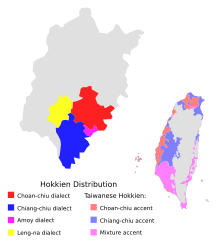Amoy dialect
| Amoy | |
|---|---|
| Amoynese, Xiamenese | |
| 廈門話 Ē-mn̂g-ōe | |
| Native to | People's Republic of China and Taiwan, Japan (due to large Taiwanese communities in Greater Tokyo Area), Singapore, Malaysia, Indonesia and Philippines, as well as other overseas settlement of Hoklo people |
| Region | City of Amoy and surrounding cities and towns. |
|
Native speakers
|
over 10 million (no recent data) (date missing) |
| Language codes | |
| ISO 639-3 | – |
| Glottolog | xiam1236 |
| Linguasphere | 79-AAA-je > 79-AAA-jeb |

Distribution of Hokkien dialects. Amoy Min is in magenta.
|
|
Amoy dialect (Chinese: 廈門話; Pe̍h-ōe-jī: Ē-mn̂g-ōe), also known as Amoynese, Amoy Hokkien, Xiamen dialect, Xiamenese or Xiamen Hokkien, is a dialect of Hokkien spoken in the city of Amoy, in the southern part of Fujian province. This dialect is often known as Hokkien in Southeast Asia. It is one of the most widely researched and studied varieties of Min Nan, and has historically come to be one of the more standardized varieties.
Spoken Amoynese and Taiwanese are both mixtures of Quanzhou and Zhangzhou spoken dialects. As such, they are very closely aligned phonologically. However, there are some subtle differences between the two, as a result of physical separation and other historical factors. The lexical differences between the two are slightly more pronounced. Generally speaking, the Hokkien dialects of Amoy, Quanzhou, Zhangzhou, Taiwan and Southeast Asia are mutually intelligible with only slight differences.
In 1842, as a result of the signing of the Treaty of Nanking, Amoy was designated as a trading port. Amoy and Kulangsu rapidly developed, which resulted in a large influx of people from neighboring areas such as Quanzhou and Zhangzhou. The mixture of these various accents formed the basis for Amoy dialect.
...
Wikipedia
